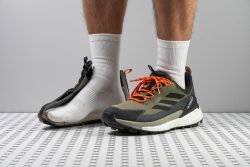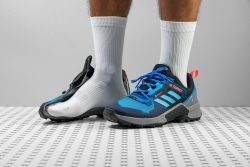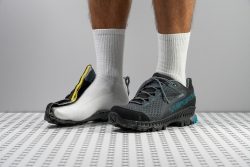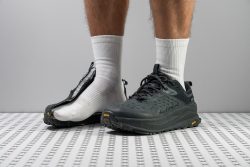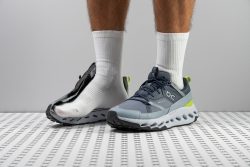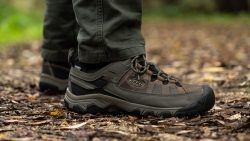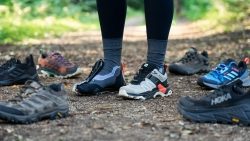7 Best Winter Hiking Shoes in 2025

We buy shoes ourselves. We earn commissions when you buy through us, at no extra cost. Why trust us
Whether you’re off to the snowy trails or just need to protect your feet from the winter weather, we’ve got great picks that will keep your toes warm, cozy, and protected. Built for the winter season, these properly insulated, cold-ready hikers will keep your footing secured on the trails.
After testing each shoe in the mountains, slipping and sliding on off-road paths and snowy trails, we have selected the best models, which will keep you upright and comfortable all winter long.
How we test winter hiking shoes
To make this recommendation, we’ve thoroughly tested all models in winter, spending significant time in each pair of shoes. We’ve also checked and analyzed the footwear inside our lab.
Our selection process involves doing these steps:
- We invest our time, energy, and our own resources to procure winter hiking shoes. This allows us to remain 100% independent and objective when publishing our reviews.
- We take each model on winter hiking excursions to personally assess its actual fit, insulation, traction, stability, durability, and support, among others. We test the models further to determine if they can handle moderate to extreme winter conditions.
- We collect more information from the test results inside our lab. We even dissect the shoes so no part is hidden from our scrutiny.
Best winter hiking shoes overall


































What makes it the best?
After vigorous testing in both our lab and on hiking, we voted the Merrell Moab 3 GTX as the best winter hiking shoe. These classic Merrells are superbly comfortable from the get-go, waterproof, and grippy on all terrain, making them the perfect choice for a winter hike.
We have come to expect comfort from the Moab range, and the Moab 3 GTX didn’t let us down. Straight out of the box, they enveloped our feet like a hug. In the lab, we measured the generous tongue to be 14.6 mm, far cushier than the average of 10.2 mm! Altogether, we enjoyed comfortable hikes with no rubbing or blisters, no break-in needed.
The Merrell Moab 3 GTX takes winter hiking seriously, and it shows up in a slew of features. The watertight upper passed our wet test with flying colors, handling submersion in a stream with ease. Our feet were completely dry, helped out by the fully gusseted tongue, which stops water from seeping in around the instep and the Gore-Tex membrane.
The sticky 4.8 mm lugs in the Vibram outsole held their ground firmly, and we felt confident hiking on muddy, snowy, or rocky trails.
The Merrell Moab 3 GTX focuses on ground feel, so those seeking maximum impact protection should check more cushioned hiking shoes.
Pros
- Superb day-one comfort
- Brilliant surface adhesion
- Supportive like a work shoe
- Remarkably durable
- A-grade waterproofing
- Sheds mud quite well
- Protective toe box
- Incredible overall quality
Cons
- Heavy for a low-top
- Subpar breathability
- Its shoelaces unravel often
- Minimal shock absorption
Winter hiking shoes with the best shock absorption
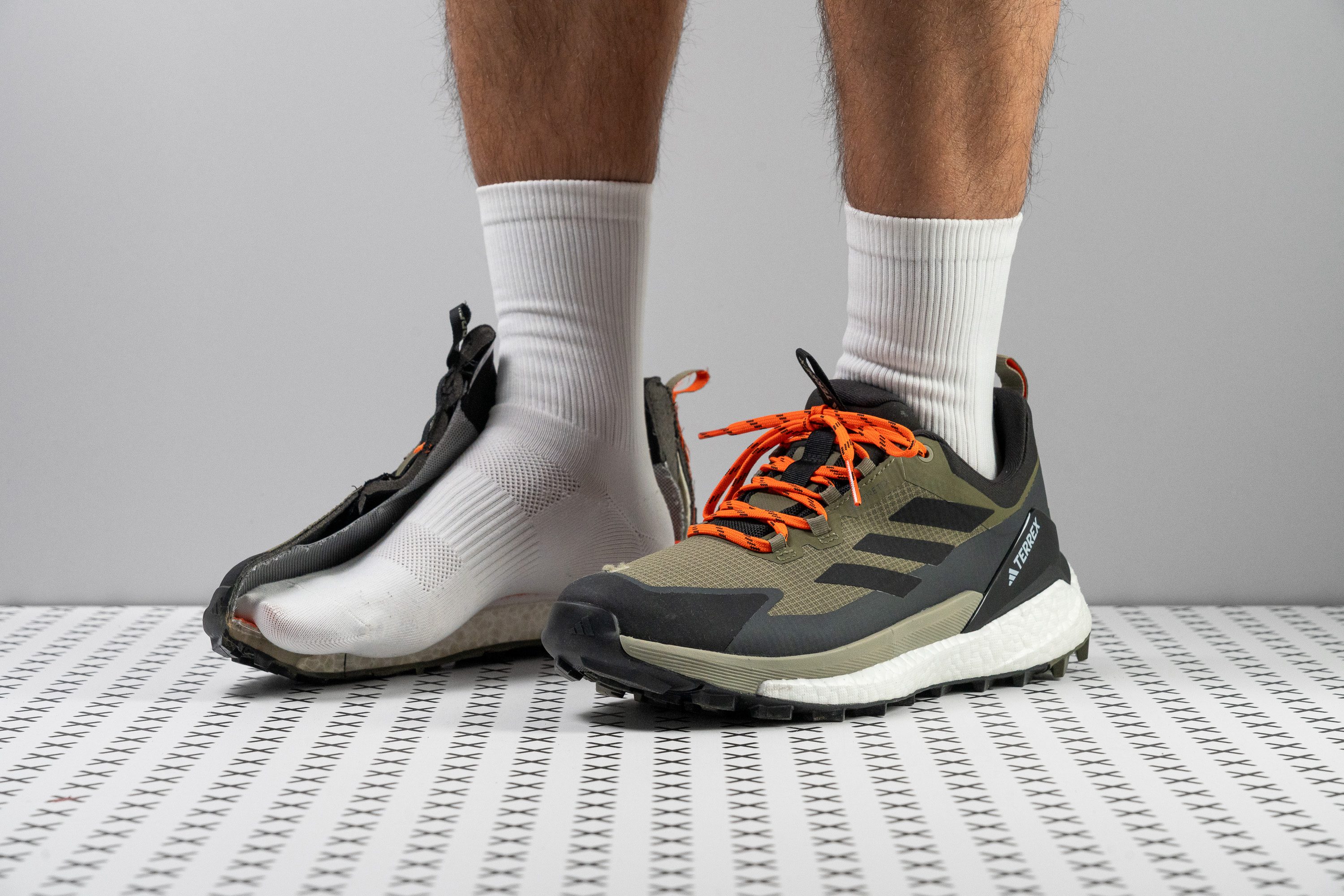



















































What makes it the best?
In our snowy hikes, the Adidas Terrex Free Hiker 2.0 Low GTX delivers supreme comfort and solid footing while keeping us warm and dry. For these reasons, it’s our winter hiking shoe with the best shock absorption. Its plush midsole is highly supportive, allowing us to tackle various terrains with confidence and ease.
We give the cushioning a 10/10 as it mutes out all the harshness of the ground, babying our legs with a generous 37.2/24.6 mm stack. The midsole offers 21.2% better impact protection vs. average, proven by its high 126 SA or shock absorption score.
Despite its height, this shoe maintains our surefootedness through its vast base and dependable grip. Our measurements reveal a massive 113.9/93.1 mm platform, giving us room to find our balance with every stride. Meanwhile, the Continental outsole has deep 6.7 mm lugs in the heel and 3.6 mm lugs in other sections, helping us maintain control even on slippery surfaces.
The airtight upper makes it our perfect winter companion, as our smoke test confirms with a 1/5 breathability score. The Gore-Tex membrane keeps melted ice and sharp winds away, sheltering our feet with much-needed warmth.
Unfortunately, the shoe is another bulky item to carry on our bodies. At 15.7 oz (445g), it’s 17.1% heavier than average.
Pros
- Well-cushioned and responsive
- A ton of impact protection
- Rockered sole makes the ride smoother
- Barely gets firmer in low temperatures
- Excellent support and side-to-side stability
- Top-notch waterproofing
- Highly durable (especially the outsole)
- Ideal grip for technical terrain
- Sustainable materials (20%)
Cons
- Much heavier than average
- TPU heel clips may cause rubbing
Winter hiking shoes with the best stability
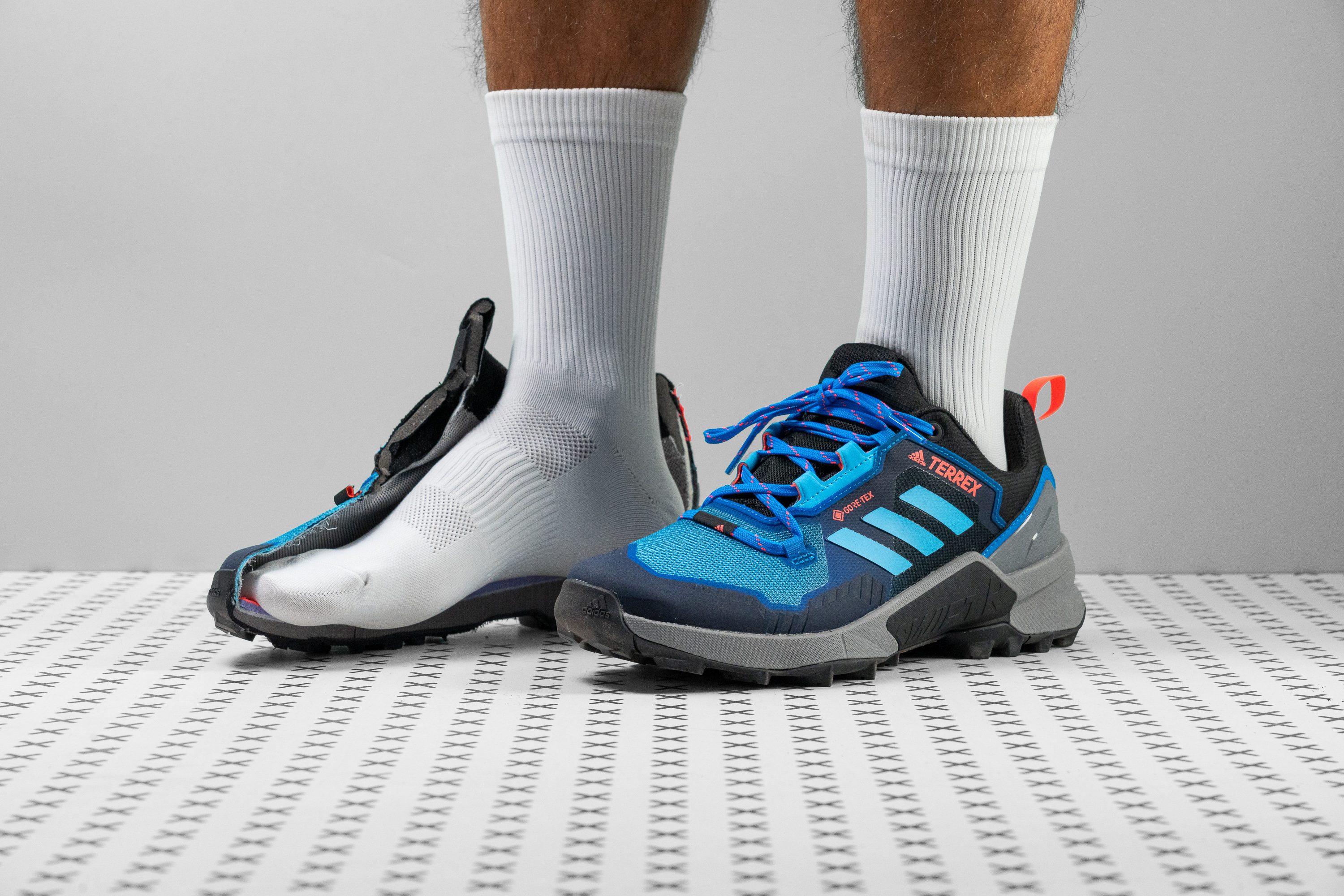













































What makes it the best?
On our winter hikes, we look for a stable shoe that keeps us from twisting an ankle, can grip well on frosty or icy surfaces, and remains comfortable in the cold. We found all that - and more! - in the Adidas Terrex Swift R3 GTX, making it our most stable winter hiking shoe.
We put the Adidas Terrex Swift R3 GTX through its paces on the trail and in the lab and we were blown away by its unbeatable stability. The Pro-Moderator technology embedded in the midsole is a force to be reckoned with, and prevents our ankles from rolling. With a firm heel counter rating 4/5 and a very rigid structure rating the stiffest score of 5/5, we felt secure and protected from twists and sprains. Overall, this shoe feels as solid as a boot on our feet, while retaining the freedom of a hiking shoe.
Snowy or muddy surfaces are no match for this shoe. Their 4.4 mm lugs are slightly deeper than the average 4.3 mm, and provide unmatched traction on everything from soft, muddy trails and snow to slippery rocks and asphalt. The rugged Continental outsole wins us over every time with its well-spaced chevron design, which sheds mud and stops us from slipping on loose descents.
With a heel stack 9% higher than average, our landings are superbly comfortable in the Adidas Terrex Swift R3 GTX. We measured the plush midsole at 26 HA, making it 18% softer than average. What makes this such a good choice for winter hikes is that, after 20 minutes in the freezer and retesting with the durometer, the midsole had only become 17% firmer, measuring 30.5 HA, which is around the firmness of most hiking shoes at room temperature. In short, this shoe gives us a plush, comfy ride in all weathers!
We don’t recommend this shoe to hikers who prefer a low heel-to-toe drop and natural walking feel. With a heel stack height measuring 36.6 mm and a more flexible forefoot stack of 20.7 mm, the drop is a huge 15.9 mm. Since the average drop in hiking shoes is 12 mm, this may not be suitable for all hikers.
Pros
- Boot-like stability
- Highly durable and protective
- Lightweight for what it offers
- Excellent waterproofing
- Breathable for a GTX shoe
- Responsive ride
- Very secure foothold
- Great grip and deep lugs for mixed terrain
Cons
- Stuffy for summer
- Can be too stiff (even stiffer in cold)
- Break-in needed
Best winter hiking shoes for backpacking
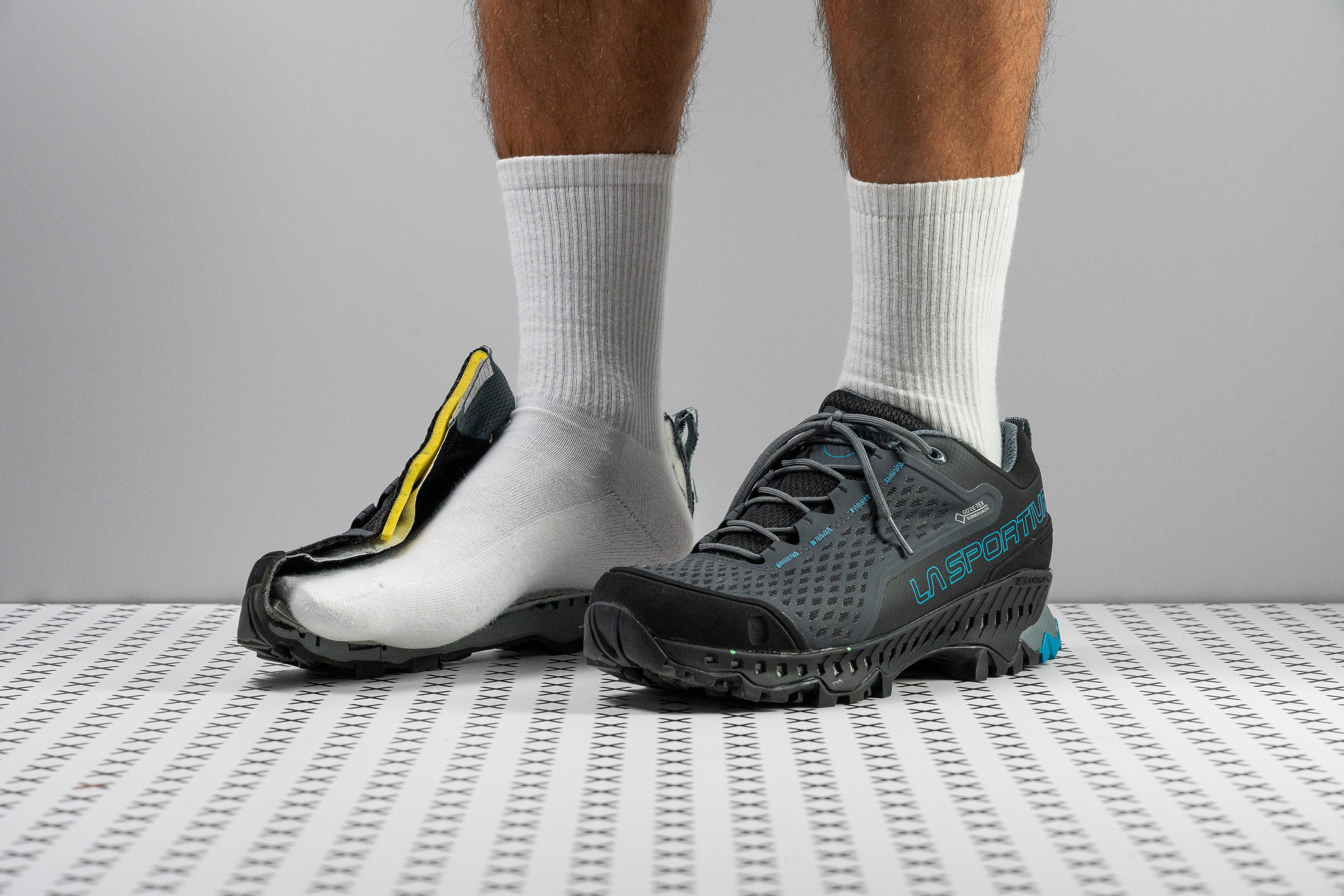





















































What makes it the best?
We found the ultimate backpacking shoe for our winter hikes during testing in and out of the lab, it’s none other than the La Sportiva Spire GTX. With the warmth, protection, and stability of boots, we felt confident during our adventures in snowy and unpredictable weather.
We had a solid and steady base guarding our feet. Our caliper reveals a massive heel foam of 39.1 mm, among the tallest we’ve encountered in the lab. This amount of foam isolated us from ground impact and debris. Meanwhile, the heel is a steep 16.0 mm incline, reducing stress on our Achilles and allowing us to last longer while carrying heavy loads.
Our durometer shows the cushion is a firm 32.6 HA, which effectively enhances stability. Additionally, the Spire GTX includes the STB control system, featuring tall sidewalls that cradle the feet securely. Below the midsole is the highly reliable Vibram outsole lined with 4.3 mm deep lugs for traction.
The upper is our ultimate shield against painfully cold winds, scoring the lowest 1/5 score on our breathability test. This score is a huge plus for winter shoes. However, the already firm midsole becomes even firmer in the cold. Those who prefer softer cushioning should look elsewhere.
Pros
- Feels like a backpacking boot with low collar
- Unparalleled stability and support
- Superb waterproofness with some breathabilty
- Mutes out rocks and debris like no other
- Excellent grip and braking
- Sturdy and durable construction
- Greater range of sizes allows to fine tune the fit
Cons
- Can feel tippy on rocky and hilly terrain
- Frail inner lining
- Gets even firmer in cold
Best winter hiking shoes with a wide toebox
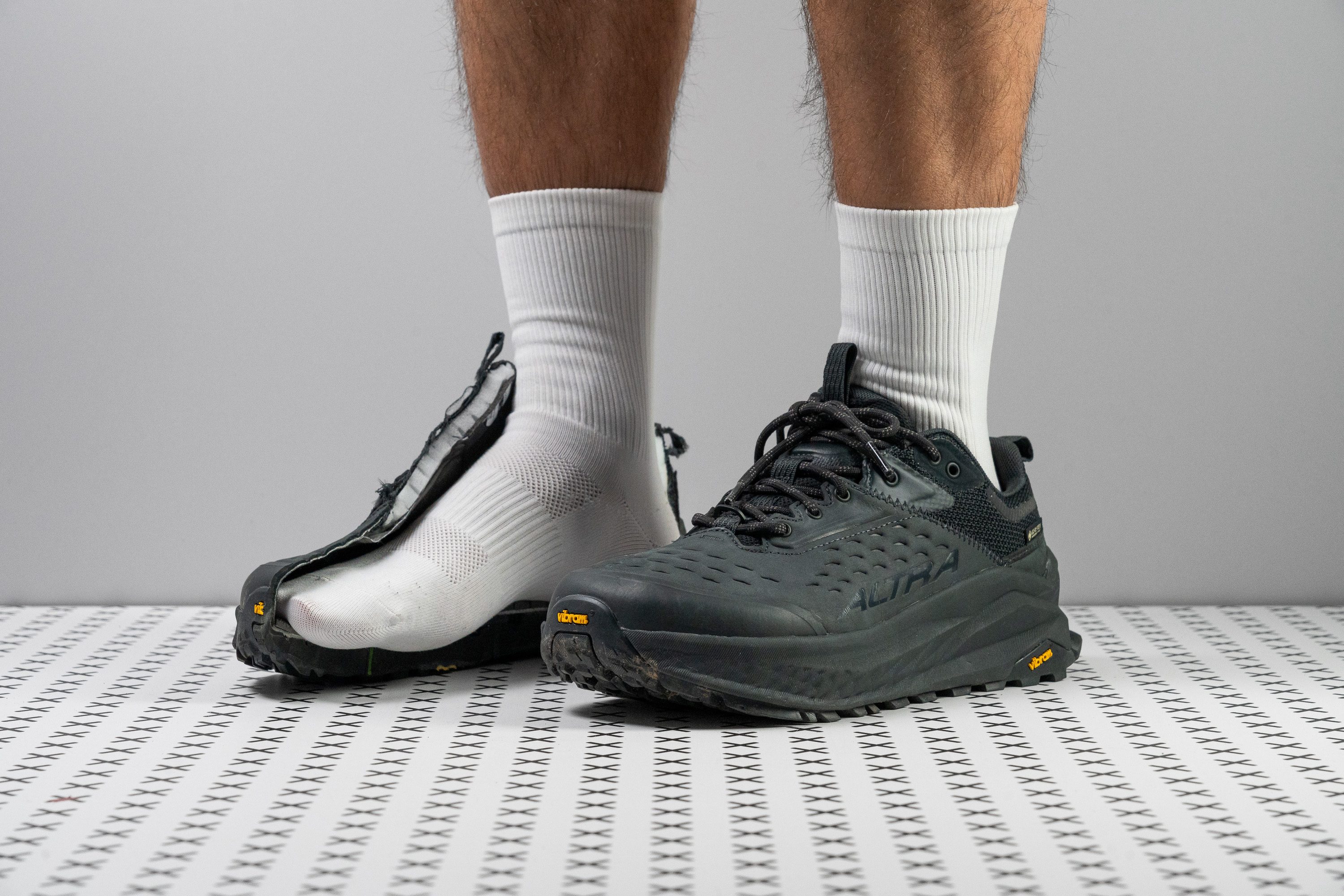
















































What makes it the best?
We took the Altra Olympus 6 Hike Low GTX to snowy mountains and enjoyed its plush, warm, and spacious sensation. This shoe really puts a premium on comfort, and our feet can’t deny it. Among winter hiking shoes we tested, this shoe exceeds expectations with its roominess, making it our best with a wide toebox.
This Altra features the Original FootShape Fit, and indeed, it can accommodate even the broadest feet comfortably in its 80.5 mm toebox, which we verified with our gel mold. For context, the average is only at 72.5 mm.
The comfort is further enhanced by the impermeable upper that kept us warm in sub-zero temperatures. Diving deeper in the lab, we found that it’s made of nubuck leather and the Gore-Tex Invisible Fit membrane. In our smoke test, nothing could escape, leaving us to award the shoe a 1/5 in breathability.
We enjoyed tons of impact protection in this pair. Even though its platform is not the tallest, it offers above-average shock absorption of 118 SA, proving its comfort for long hours of trekking.
However, we find that its stiff build may be an overkill for light hikes. For an easy stroll in the park, we recommend a more flexible shoe.
Pros
- Excellent shock absorption
- Comfortably soft cushioning
- Ultra padded and cozy step-in feel
- Exceptionally wide fit and footshaped toebox
- Extra wide and stable platform
- Highly durable leather and outsole
- Excellent grip on smooth and wet rocks
- Solid waterproofing
Cons
- Not a true zero-drop (1.5 mm)
- Midsole gets notably firmer in cold
- Frail inner lining
Best lightweight winter hiking shoes
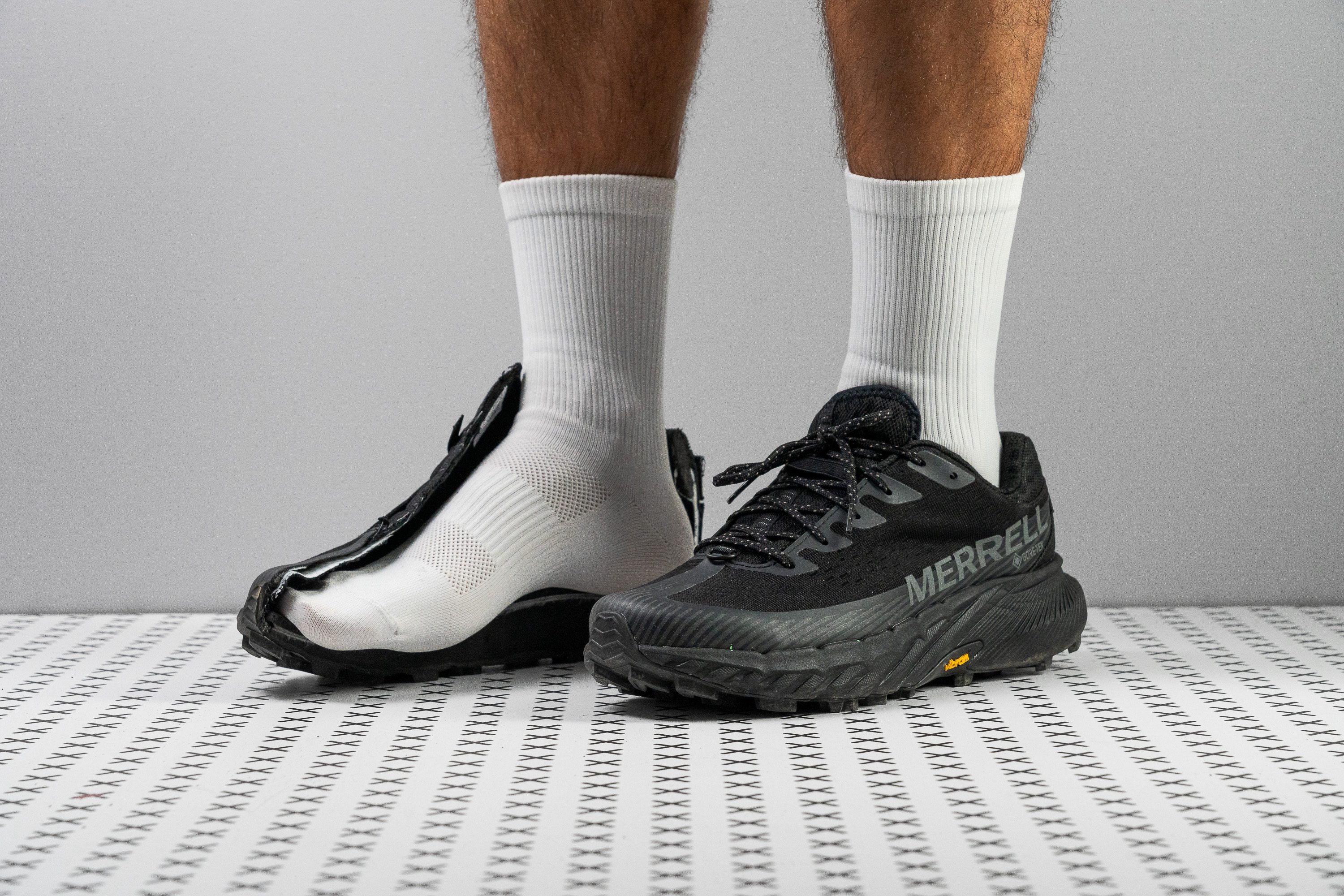













































What makes it the best?
The Merrell Agility Peak 5 GTX proved to us in our mountain adventures that it’s ready for any terrain in wet, cold weather. A mix of lab tests reveals its reliable traction, its dense and protective upper, and its flexible midsole and minimal build, making it easy to maneuver. Ultimately, it’s our top lightweight winter hiking shoe.
With its low 10.4 oz (296g) figure on our scales, we could even jog or run if we want to. For reference, the average hiker is 22.1% heavier. It’s far from being a burden on our feet, even during long-haul treks. Comfort is further improved through its low resistance to bending, and we found it 5.9% more flexible than average.
We felt secure as we traversed snow-covered trails because the outsole delivered the traction we needed. We observed deep 4.4 mm chevron lugs underneath, biting the ground so that we can take controlled strides. They are spaced properly to be able to shed soft ground effectively.
Meanwhile, the upper shields us from harsh winds and melted snow. It is incredibly compact and has Gore-Tex lining, so we rated it with the minimum 1/5 breathability score. It proved its impermeability in our smoke test, keeping us warm and dry.
Unfortunately, the toebox tapers aggressively, leaving little room for thick socks or swollen feet. We can only recommend this shoe to hikers with narrow to medium-sized feet.
Pros
- True waterproof protection
- Grippy, trail-ready Vibram outsole
- Perfect for cold, wet climates
- Can handle some challenging conditions
- Stable yet cushioned heel
- Improved for hiking and walking
- Well-designed outsole lugs
- Great build quality
- Keeps feet warm
- Rock plate
Cons
- Narrow toebox
- Heel padding durability concerns
- No reflective elements
- Drop differs too much from stated
Best city-to-trail winter hiking shoes
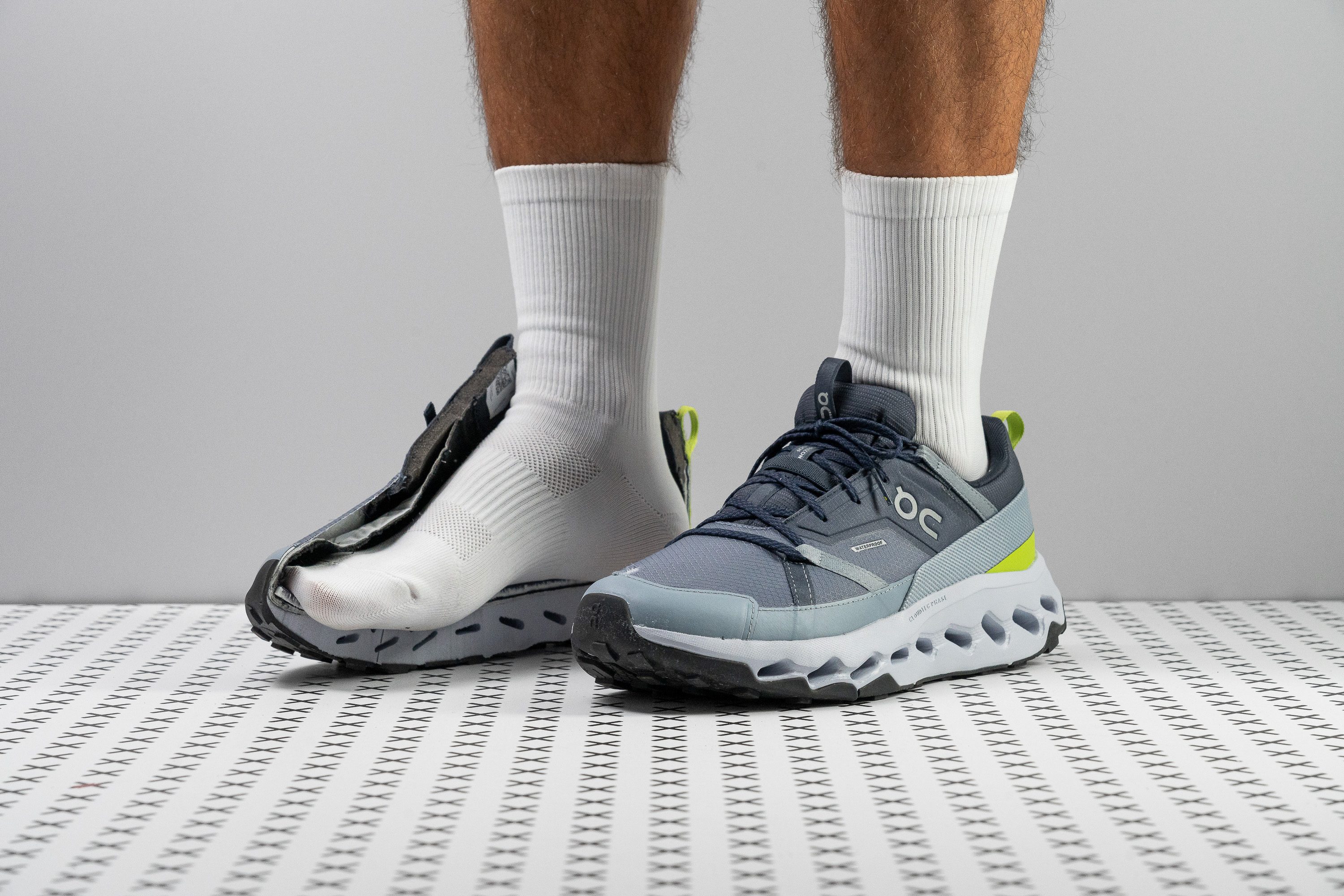




















































What makes it the best?
The cold never bothered us while trekking with the On Cloudhorizon Waterproof. It features a winterproof woven textile that retains our warmth and substantial cushioning that makes our legs feel at home. In the lab, we found it to be exceptionally light, making it our best city-to-trail winter hiking shoe because of its no-nonsense nature.
The Cloudhorizon Waterproof feels far from breathable, which is exactly what we want when the mercury drops. It keeps our body heat trapped inside the shoe and refuses to let cold air in, as demonstrated by our smoke test; it earns the minimum 1/5 ventilation score.
The midsole features generous cushioning and the one-of-a-kind CloudTec technology that absorbs ground impact. We measured a massive stack height of 39.4/29.2 mm, with the rear offering outstanding shock absorption of 126 SA. Even with repetitive pounding on the pavement, the midsole keeps our legs fresh.
What helps soothe the ride is Cloudhorizon Waterproof’s minimal 12.0 oz (339g) construction, making it 10.8% lighter than average.
However, it may burn a hole in the pocket with its $190 price tag. It costs 33.8% above the average hiking shoe, so we recommend those on a budget to explore cheaper alternatives.
Pros
- Effective waterproofing
- Abundant cushioning and impact protection
- Lively and responsive ride
- Amazingly light for its stack and waterproofing
- Great as a city-to-trail shoe
- Good stability for moderate terrain
- Comfortable in-shoe feel
- True to size and fit
Cons
- Not for serious hiking
- Lacks durabiity for the price
3 things to focus on when buying winter hiking shoes
When hiking in winter, we distinguish between 3 different types of weather conditions: when it’s cold and dry, when it’s rainy/snowy, and when the surface is very wet.
Based on them, we give different recommendations on what to look for in a hiking shoe:
- It’s cold yet dry. Look for hiking shoes that are warm (i.e., don’t breathe well). In our lab, that means scoring 1 or 2 on a scale of 1 to 5. We consider these shoes winter-friendly.
- You expect rain or snow. Look for waterproof hiking shoes that don’t breathe well. By default, most of them don’t. Usually, their names contain waterproof, WP, or GTX. It’s also best when those shoes have gusseted tongues.
- If the surface is wet, mushy, or soggy, the focus is on the grip. Look for hiking shoes with deep lugs (4 mm and above).
Regardless of these conditions, we prioritize shoes that don’t change their features significantly when taken to freezing temperatures. In the lab, we test that by measuring softness and flexibility at room temperature and at freezing temperatures.
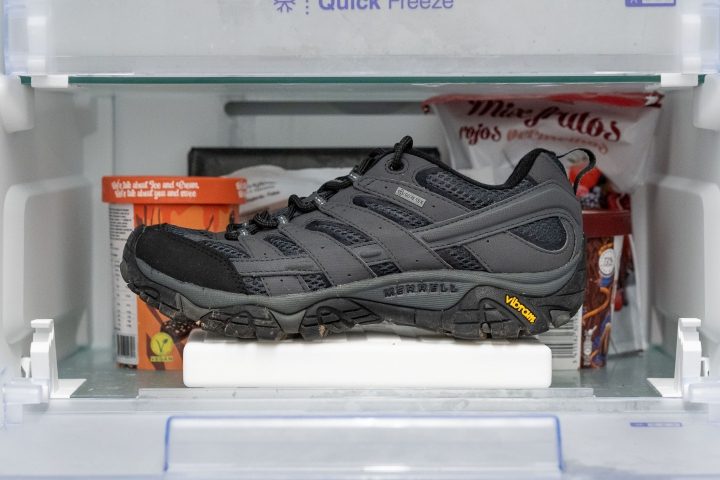
Yes, we simulate the cold weather by putting the shoes in the freezer. We cover this in detail further down.
If you plan to hike in snowy conditions where the snow levels are higher than the bottom of your ankles, we advise getting a pair of hiking boots instead of shoes. The best thing is, they can be insulated, which means extra warmth!
Prioritizing warmth in hiking shoes for winter
Nobody likes frozen toes, so here’s our advice on how to find hiking shoes that provide warmth on winter days. We recommend shoes that are not breezy. In the lab, we test the breathability by pumping the smoke into the shoe and examining where and at which rate the smoke comes out.
In this video, we see how a winter shoe on the right lets way less smoke out when compared to the breathable, summer shoe on the left.
The breathability rating goes from 1 to 5. Shoes rated 1 or 2 we consider not breathable and, therefore, winter-friendly.
We also examine the upper of the hiking shoes under the microscope. The non-breathable ones are very tightly woven with no perforation holes:

Breathable ones, that score 4 or 5, are a completely different story. See examples in the image:
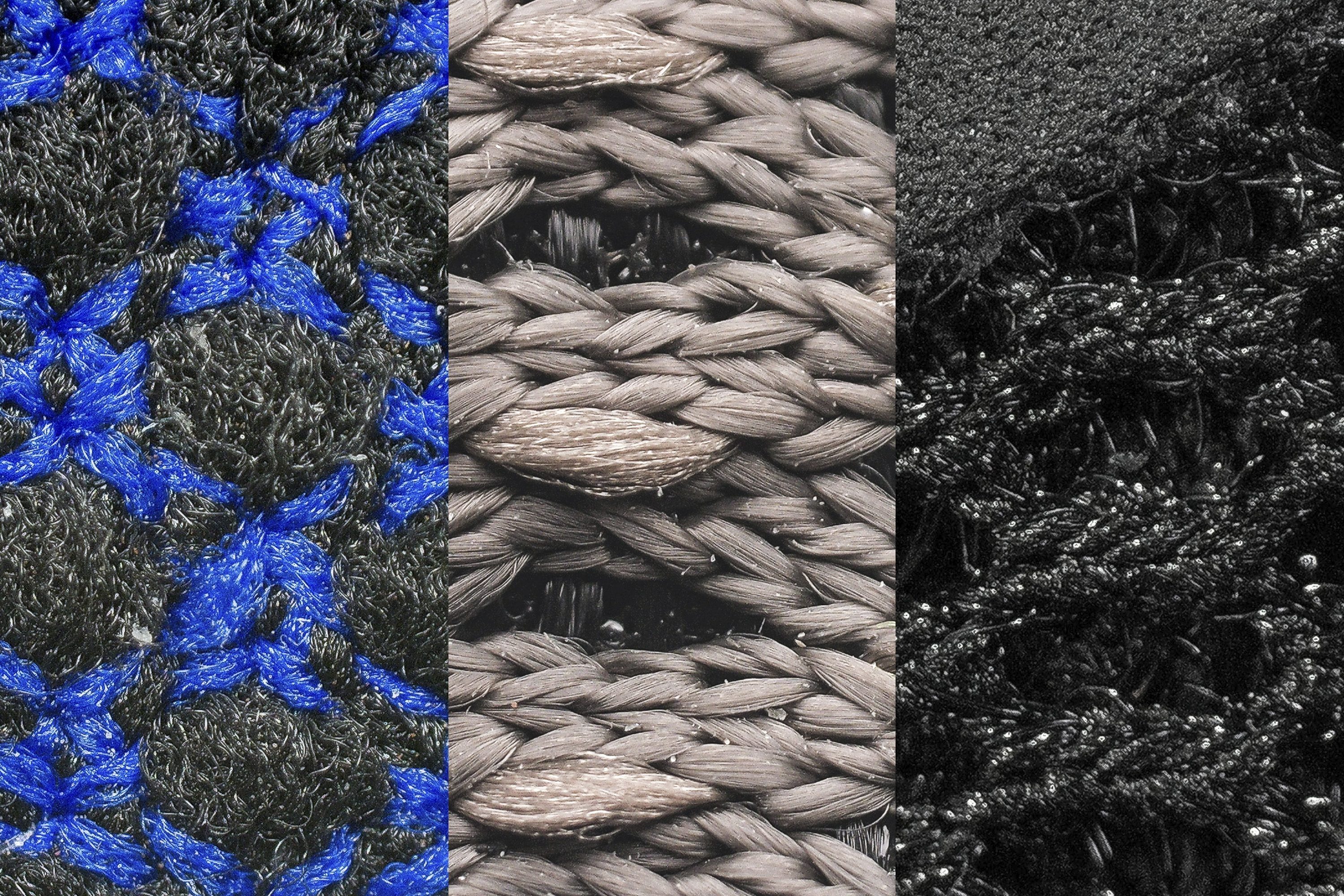
Waterproof hiking shoes: Best protection from rain and snow
Winter hiking usually involves some exposure to wet elements. If this is your plan, we strongly recommend choosing hiking shoes that are waterproof.
When doing wear-testing, we always test waterproof hiking shoes in the rain, puddles, shallow streams, and similar conditions. In the lab, we test the breathability that always corresponds to the waterproofness level we experienced in the field (waterproof shoes are by default less breathable).
If not sure whether the shoes are waterproof, be sure to check the full shoe name or the specifications. The most common waterproof membrane is called GORE-TEX or GTX.
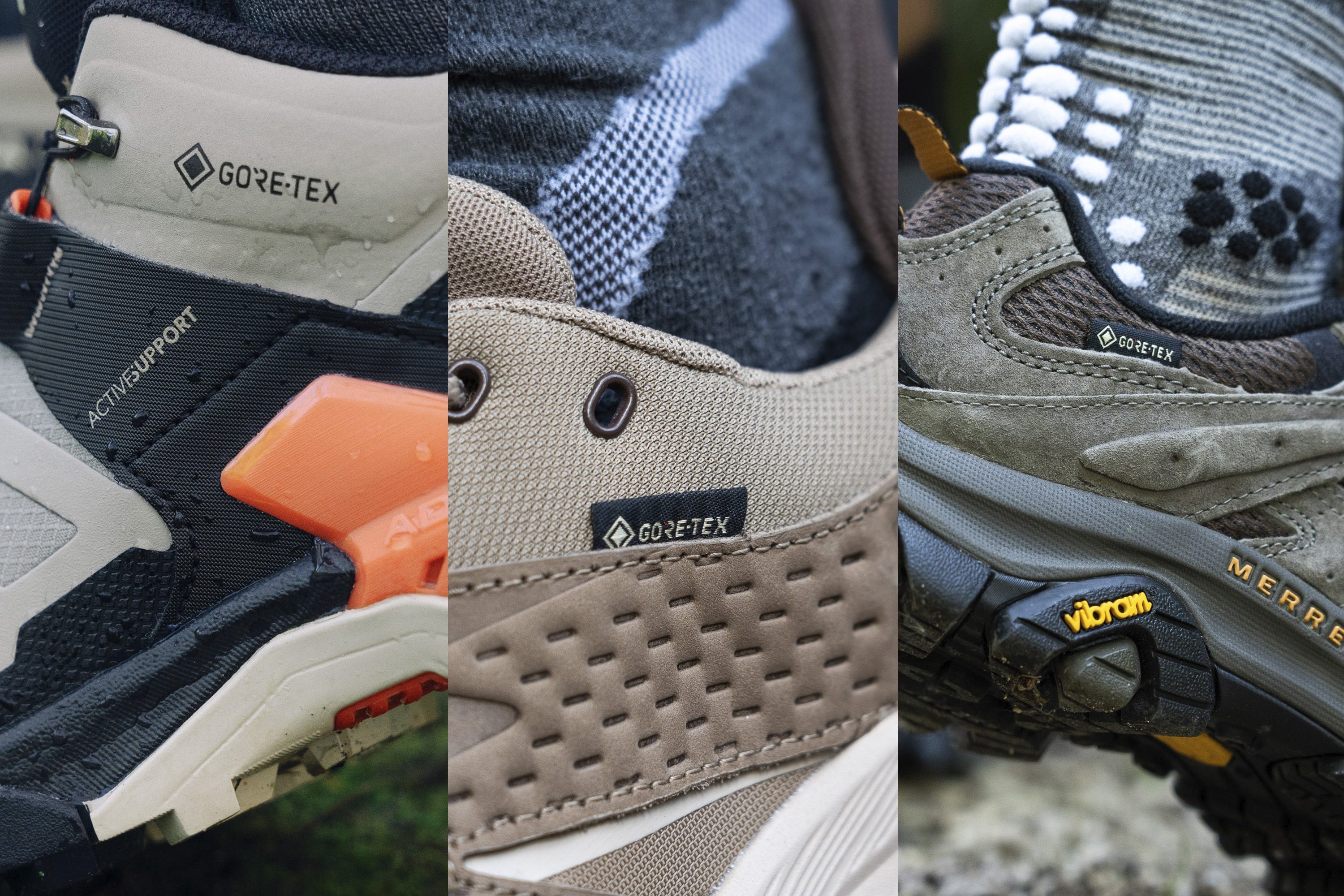
There are other membranes like eVent® or Hydroguard®, and sometimes the name simply includes Waterproof or WP.

Keep in mind that the waterproof hiking shoes are less breathable than the non-waterproof ones.
Why gusseted tongues are a must
They are better at keeping the snow, water and debris outside of the shoe because they are attached to both sides of the shoe, just below the eyelets on the inner side.
Here’s what a gusseted tongue looks like. It is fully attached to the sides:

In the lab, we check the type of the tongue and note it down in the full-specs sheet. It’s easy to notice the type of gusset just by examining the shoe, but it is much more noticeable once the shoe has been cut in half.
Lugs must be deep!
Deeper lugs simply bite into the ground better, especially when it’s wet: be it snow, mud, or slush. The deeper the lugs, the better the traction. We recommend 4 mm and above for soft and loose wet ground and up to 4 mm for hard, flat surfaces like rocks. In the lab, we measure the depth of the lugs with a caliper.
In the example below, we can see that the Fivefingers V-Trek has lugs that are only 2.1 mm deep. On the right, however, the Anacapa Low GTX has 5-mm deep lugs.

However, if it’s mostly mud, which is the stickiest out of the three (snow, mud, slush), our recommendation is to look for lugs that are at least 4 mm deep and not too close to each other. When they have a bit more space between them, they shed the mud better.
To explain it visually, have a look at Speedcross 6, which is a trail running shoe perfect for mud, and New Balance Nitrel 5, which is more of a do-it-all. Notice how the lugs are deeper and more distant on the first shoe that specializes in mud:
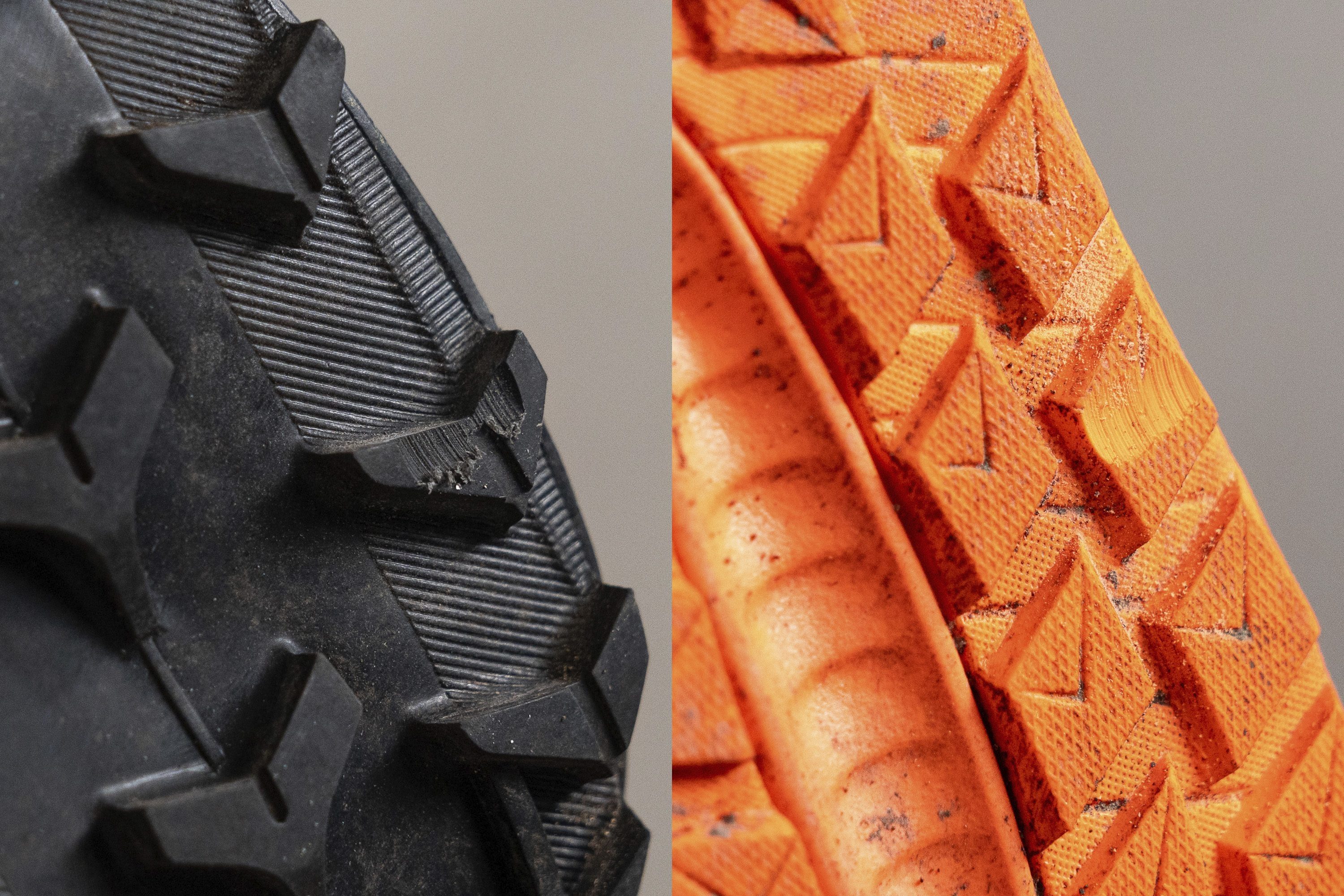
Shock absorption of winter hiking shoes
Regardless of the season, a protective ride is a must. However, here, we're not talking about external factors like bad weather, sharp rocks, etc., but about the harsh impact forces that can hurt hikers' feet. This is why we focus on shock absorption and the midsole's capability to dampen the impact. The higher the shock absorption, the better for the hiker.
Testing the shock absorption of winter hiking shoes in RunRepeat lab
While shock absorption is not so important for very short hikes, especially done by lightweight hikers, it becomes increasingly more important as the mileage grows or backpacks become heavier.
Durability of winter hiking shoes
Hiking shoes with deeper lugs are usually made of softer rubber. This rubber tends to be less durable, but it is not a rule. The durability of the upper in hiking shoes is always a topic of interest, as not all hikes happen on spotless trails.
In our lab, we test for both using our Dremel. We press it against the upper and the outsole and measure or assess the damage they sustained. The durability of the upper is assessed on a scale 1-5, where 5 is the most durable. The outsole, however, is measured in the depth of the dent our Dremel has made. More millimeters, less durability.
If you’re worried about the durability of your next pair of hiking shoes, look at our list of top 5 most durable winter hiking shoes (here, we prioritized the outsole durability):
How softness and flexibility change with the temperature
We like putting shoes in the freezer. Because this allows us to anticipate how the shoes will feel and perform in cold weather.

First, we measure a durometer to measure the softness of the hiking shoe. We push it against the midsole after we’ve cut the shoe in half. The lower the number on the durometer, the softer the shoe.
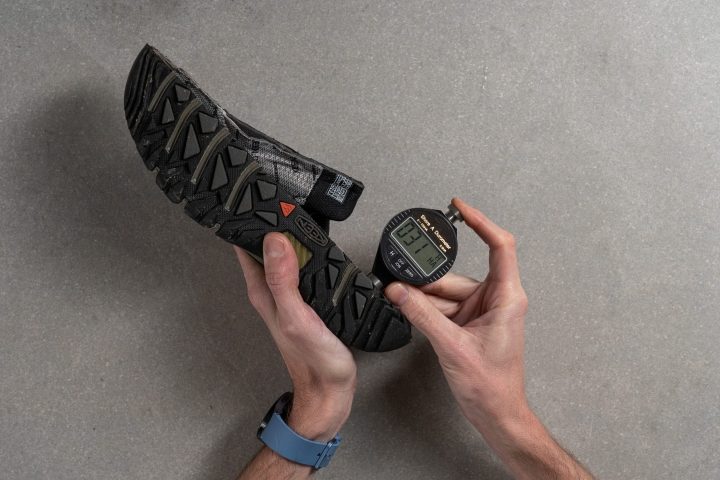
Then, we measure the flexibility of the shoe we did not cut in half. We clamp it to the table and bend it with a force gauge. The higher the number (force) on the gauge, the stiffer the shoe.
Then, we repeat this test after the shoe has spent 20 minutes in the freezer. For winter hiking, it is important that the changes (in %) are not big. The worst-case scenario is that the shoe stiffens up and firms up a lot (say 50% or more). If it also started with numbers higher than the average, then we can assume it will feel like a brick once taken to the cold area.
See the top 5 hiking shoes that have firmed up the least in this test. We also added their change in flexibility.
Socks for winter hiking
Without a doubt, the best socks for winter are cushioned socks made of wool. Today, Merino wool is usually used, usually at least in some percentage. Wool socks dry quickly, which is very important in case your feet sweat, or the water/snow does get inside.
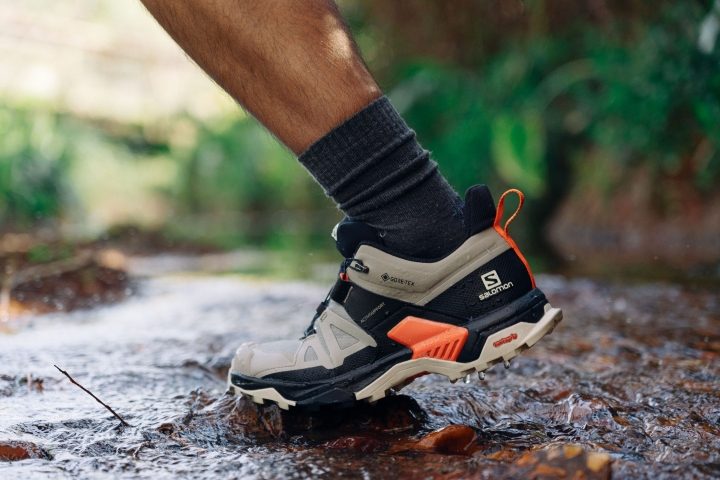
They also tend to stay odor-free, thanks to their natural antimicrobial feature. And, they are made of a natural material (unlike, say, nylon socks). And, as if we needed anything else, they tend to warm the feet even when they get wet (unlike, say, polyester socks).
Before buying any kind of hiking shoes
If you’re actually new to hiking shoes, we suggest starting with the basics. From how to find the perfect fit in hiking shoes and which shoes are best for technical terrain to shoes for backpacking and types of midsoles. We’ve covered it all in the Best hiking shoes guide.


